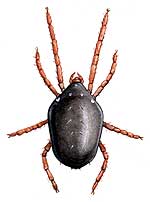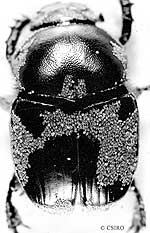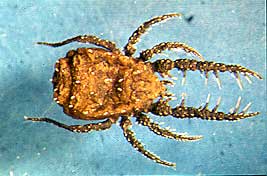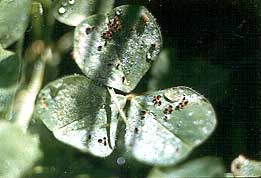|
Acarina:
mites and ticks
Characteristics
Mites and ticks belong to one of the most diverse group of all the
arachnids and can range in size from minute up to 1 centimetre.
Due to their diverse appearance a general description is difficult
to give, however all have the following characteristics:

Halotydeus destructor
(redlegged earth mite) |

Dung beetle infested with mites
|
|
|
- 4 pairs of legs, although some juveniles only have 3 pairs gaining
a forth pair with their first moult
- No external segmentation of the abdomen, individuals appear
as a single body mass
- Never have antennae
Life Cycle
Reproduction
in mites and ticks is very variable with some species mating through
the direct transfer of sperm via coupling of the genital regions.
Other species transfer sperm indirectly with the male placing a
sperm droplet on the genital opening of the female with his legs
or chelicerae.
After fertilisation the female will usually lay her eggs in the
substrate where they are left to hatch. The first free-living stage
is called a larva and has only 3 pairs of legs. After the first
moult
it will gain its fourth pair of legs and will moult
several more times before becoming a mature adult.
Feeding
Most species
of mites are predatory and will feed on a variety of small invertebrates,
while others are more herbivorous
and often feed on plant sap, sometimes causing damage to agricultural
crops and garden plants. Ticks are adapted to feeding on the blood
of vertebrate animals such as humans, dogs or livestock.
Habitat
Mites
are found in almost all habitat types including terrestrial, freshwater
and marine environments. Terrestrial mites are commonly found in
soil or leaf litter, under the bark of trees or feeding on the leaves
and stems of plants. Both mites and ticks can be found living as
parasites
of other invertebrate and vertebrate animals. Most ticks are only
discovered after they have attached themselves to a host animal.

Predatory
soil mite (CAECULIDAE)
|

Redlegged
earth mite feeding on clover leaves
|
|